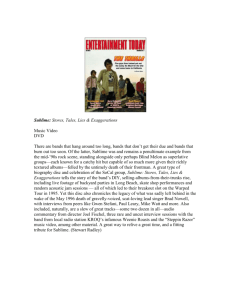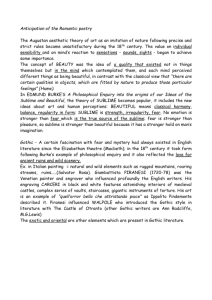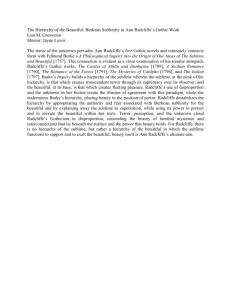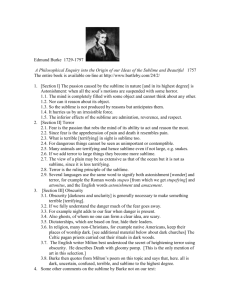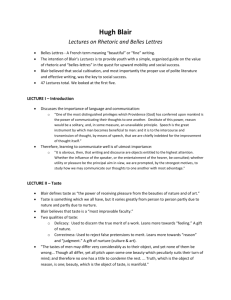The Sublime The Picturesque The Beautiful
advertisement
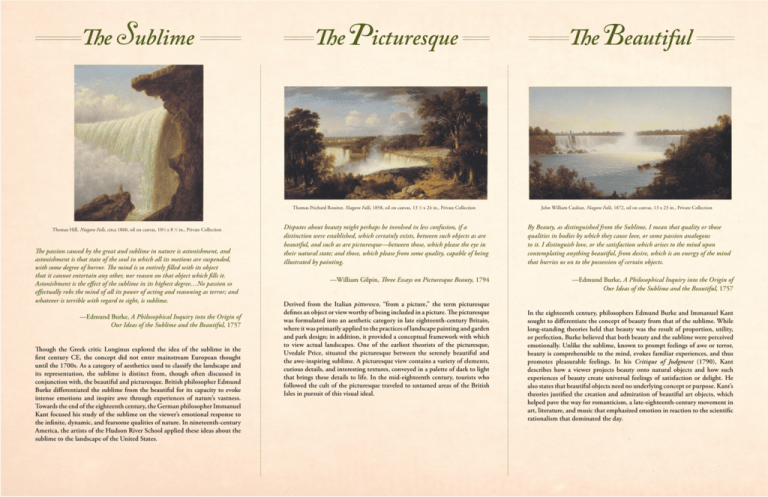
The Sublime The Picturesque Thomas Prichard Rossiter, Niagara Falls, 1858, oil on canvas, 13 1⁄2 x 24 in., Private Collection Thomas Hill, Niagara Falls, circa 1860, oil on canvas, 101⁄2 x 8 1⁄2 in., Private Collection The passion caused by the great and sublime in nature is astonishment, and astonishment is that state of the soul in which all its motions are suspended, with some degree of horror. The mind is so entirely filled with its object that it cannot entertain any other, nor reason on that object which fills it. Astonishment is the effect of the sublime in its highest degree…No passion so effectually robs the mind of all its power of acting and reasoning as terror; and whatever is terrible with regard to sight, is sublime. —Edmund Burke, A Philosophical Inquiry into the Origin of Our Ideas of the Sublime and the Beautiful, 1757 Though the Greek critic Longinus explored the idea of the sublime in the first century CE, the concept did not enter mainstream European thought until the 1700s. As a category of aesthetics used to classify the landscape and its representation, the sublime is distinct from, though often discussed in conjunction with, the beautiful and picturesque. British philosopher Edmund Burke differentiated the sublime from the beautiful for its capacity to evoke intense emotions and inspire awe through experiences of nature’s vastness. Towards the end of the eighteenth century, the German philosopher Immanuel Kant focused his study of the sublime on the viewer’s emotional response to the infinite, dynamic, and fearsome qualities of nature. In nineteenth-century America, the artists of the Hudson River School applied these ideas about the sublime to the landscape of the United States. Disputes about beauty might perhaps be involved in less confusion, if a distinction were established, which certainly exists, between such objects as are beautiful, and such as are picturesque—between those, which please the eye in their natural state; and those, which please from some quality, capable of being illustrated by painting. —William Gilpin, Three Essays on Picturesque Beauty, 1794 Derived from the Italian pittoresco, “from a picture,” the term picturesque defines an object or view worthy of being included in a picture. The picturesque was formulated into an aesthetic category in late eighteenth-century Britain, where it was primarily applied to the practices of landscape painting and garden and park design; in addition, it provided a conceptual framework with which to view actual landscapes. One of the earliest theorists of the picturesque, Uvedale Price, situated the picturesque between the serenely beautiful and the awe-inspiring sublime. A picturesque view contains a variety of elements, curious details, and interesting textures, conveyed in a palette of dark to light that brings these details to life. In the mid-eighteenth century, tourists who followed the cult of the picturesque traveled to untamed areas of the British Isles in pursuit of this visual ideal. The Beautiful John William Casilear, Niagara Falls, 1872, oil on canvas, 13 x 23 in., Private Collection By Beauty, as distinguished from the Sublime, I mean that quality or those qualities in bodies by which they cause love, or some passion analogous to it. I distinguish love, or the satisfaction which arises to the mind upon contemplating anything beautiful, from desire, which is an energy of the mind that hurries us on to the possession of certain objects. —Edmund Burke, A Philosophical Inquiry into the Origin of Our Ideas of the Sublime and the Beautiful, 1757 In the eighteenth century, philosophers Edmund Burke and Immanuel Kant sought to differentiate the concept of beauty from that of the sublime. While long-standing theories held that beauty was the result of proportion, utility, or perfection, Burke believed that both beauty and the sublime were perceived emotionally. Unlike the sublime, known to prompt feelings of awe or terror, beauty is comprehensible to the mind, evokes familiar experiences, and thus promotes pleasurable feelings. In his Critique of Judgment (1790), Kant describes how a viewer projects beauty onto natural objects and how such experiences of beauty create universal feelings of satisfaction or delight. He also states that beautiful objects need no underlying concept or purpose. Kant’s theories justified the creation and admiration of beautiful art objects, which helped pave the way for romanticism, a late-eighteenth-century movement in art, literature, and music that emphasized emotion in reaction to the scientific rationalism that dominated the day. For gallery use only Download this guide from www.blantonmuseum.org/AmericanScenery American Scenery: Different Views in Hudson River School Painting is organized and toured by the Westmoreland Museum of American Art, Greensburg, PA. Support for the exhibition at The Blanton is provided by Mr. and Mrs. Jack S. Blanton, Sr., George and Nicole Jeffords, Dana and Gene Powell, Mary Ann and Larry Faulkner, Suzan and Julius Glickman, Ginni and Richard Mithoff, Kay M. Onstead, and the Taconic Charitable Foundation. The Universi ty of Texas at Austin | MLK at Congress Austin, TX 78701 | www.blantonmus eum.org | (512) 471-7324

